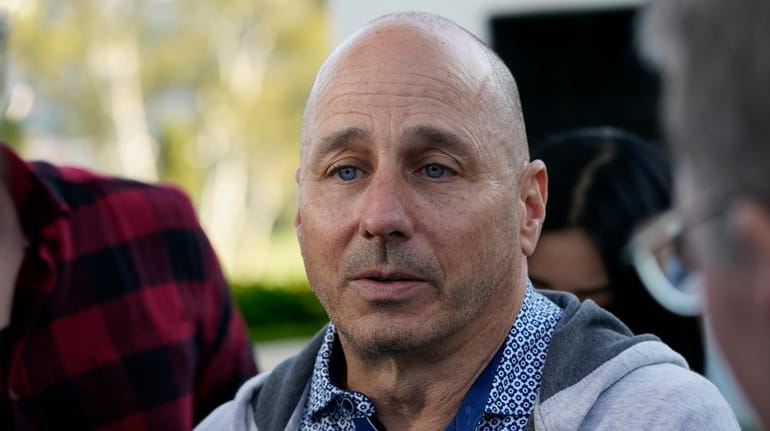Would Yanks exceed tax threshold in pursuit of shortstop?

Yankees general manager Brian Cashman talks with reporters during Major League Baseball's general managers meetings Tuesday, Nov. 9, 2021, in Carlsbad, Calif. Credit: AP/Gregory Bull
CARLSBAD, Calif. — Yankees managing general partner Hal Steinbrenner made it an organizational goal years ago to get under the luxury-tax threshold in order to avoid the tax bill that comes with surpassing it.
This past year, though it didn’t result in a World Series victory, the Yankees were successful in that regard.
Payroll came in under the $210 million tax threshold, which allowed the Yankees to reset their tax (the Yankees got under the threshold in 2018 but blew past it in 2019 and ’20).
And that could allow general manager Brian Cashman to spend a bit more this winter, though "could" remains the operative word as Steinbrenner has also made clear in the past he doesn’t view it as necessary to be over the tax on a yearly basis. (Had the Yankees gone over this season they would have been assessed a 50% tax on every dollar spent over $210 million, as any club going over three straight years is.)
Still, it was, Cashman said, "mission accomplished" in resetting the tax and, as a result, the longtime GM added Tuesday afternoon, early indications in budget talks with Steinbrenner suggest "I have some latitude" when it comes to money and the construction of the 2022 team.
Naturally, that led to plenty of questions regarding this winter’s free-agent class, which is highlighted by a slew of star players at shortstop — Carlos Correa, Corey Seager, Trevor Story, Marcus Semien and Javy Baez, just to name a handful.
The industry expectation is that Correa will get the biggest deal of any free agent this offseason, maybe even something rivaling the 10-year, $341 million contract Francisco Lindor received from the Mets.
"\[It’s\] the year of the shortstop, clearly, with a lot of high-end, talented players coming out at the same time," Cashman said Tuesday on the first day of the annual general managers meetings at the Omni La Costa Resort. "It’s an impressive group of players, no doubt."
Cashman said he already has had meetings with the agents representing two of the high-profile shortstops on the market, though he would not say who.
Correa is the best overall player of the group, though the lefthanded-swinging Seager is seen by many as the better fit at Yankee Stadium. The Yankees could end up with one of the aforementioned or neither, as whatever extra "latitude" Cashman is given in terms of money could be dispersed elsewhere.
"We’ll assess what’s available in the trade market, what’s available in the free-agent market," Cashman said. "I don’t know what the price points are and how it potentially fits with everything we’ve already got. So that’s currently what I’m going through — to see what’s realistic, what’s not realistic."
Cashman mentioned that upgrading at shortstop — defensively especially — is one of his top priorities. That coming as a result of the failed two-year experiment of Gleyber Torres manning the position. Torres, should he still be a Yankee next season, will be at second base.
Other priorities?
"Maybe centerfield," Cashman said. "I’d say anything and everything. Your job is to be open-minded . . . [and there’s] always pitching, pitching, pitching."
In regard to center, Aaron Hicks is a candidate to play winter ball after recovering from the season-ending surgery he underwent in May to repair a tendon sheath tear in his left wrist. Though the Yankees wouldn’t send Hicks to winter ball if he wasn’t deemed healthy, the 32-year-old has been injury-plagued most of his career, so there’s some uncertainty there.
As there is at first base.
The Yankees like Anthony Rizzo, a trade deadline acquisition whom they could re-sign as a free agent, but they could also go the trade route and pursue someone like A’s first baseman Matt Olson, another lefty bat in whom they have expressed an interest in the past.
Clouding everything is what will happen with the collective bargaining agreement. It is set to expire Dec. 1 and the expectation is owners will lock out players Dec. 2 if no agreement is reached, thus freezing all offseason activity until a new one is hammered out.
"I can’t really answer that question, so it’s business as usual," Cashman said of the impact the expiring CBA, and the parameters of a new agreement, would have on his winter approach.
"We’re going through our conversations thus far under the current agreement, and if it changes, we’ll adjust to those changes."
